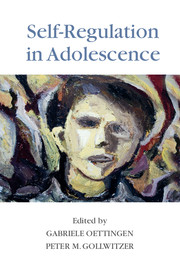Book contents
- Self-Regulation in Adolescence
- The Jacobs Foundation Series on Adolescence
- Self-Regulation in Adolescence
- Copyright page
- Contents
- Preface
- Contributors
- Part I Concepts and Processes of Self-Regulation
- Part II Historical and Biological Influences
- Part III Neural Mechanisms
- Part IV Peer and Parent Relationships
- 11 Goals and Goal Pursuit in the Context of Adolescent-Parent Relationships
- 12 Self-Regulation and Adolescent Substance Use
- 13 The Cultural Context of Adolescent Self-Regulation
- Part V Interventions
- Author Index
- Subject Index
- References
11 - Goals and Goal Pursuit in the Context of Adolescent-Parent Relationships
from Part IV - Peer and Parent Relationships
Published online by Cambridge University Press: 05 October 2015
- Self-Regulation in Adolescence
- The Jacobs Foundation Series on Adolescence
- Self-Regulation in Adolescence
- Copyright page
- Contents
- Preface
- Contributors
- Part I Concepts and Processes of Self-Regulation
- Part II Historical and Biological Influences
- Part III Neural Mechanisms
- Part IV Peer and Parent Relationships
- 11 Goals and Goal Pursuit in the Context of Adolescent-Parent Relationships
- 12 Self-Regulation and Adolescent Substance Use
- 13 The Cultural Context of Adolescent Self-Regulation
- Part V Interventions
- Author Index
- Subject Index
- References
Summary
Judith G. Smetana, Department of Clinical and Social Sciences in Psychology, University of Rochester.
Correspondence concerning this chapter should be addressed to Judith G. Smetana, University of Rochester, Meliora Hall, RC 270266, Rochester, New York 14627. E-mail: [email protected]
- Type
- Chapter
- Information
- Self-Regulation in Adolescence , pp. 243 - 265Publisher: Cambridge University PressPrint publication year: 2015
References
- 5
- Cited by

